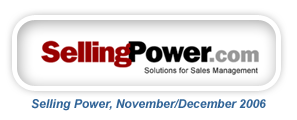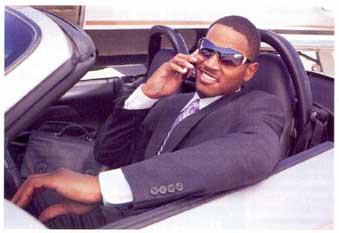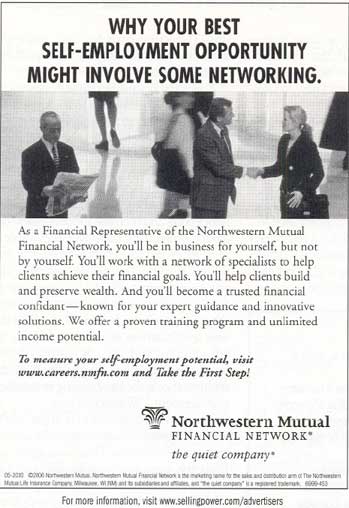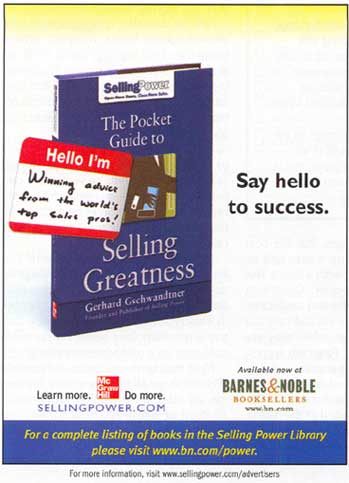
Driving Down the Cost of Driving
How to track and control hidden sales fleet costs
Forget spiraling gas prices. When you put
your salespeople on the road, you're not
just paying for cars and gas. There's a
whole set of costs and responsibilities your
company assumes. These hidden fleet
costs can add up to major dollars for a
sizable fleet. Smart companies try to minimize
all these costs for their own good, as
well as the welfare of their sales reps.

Take first the costs of accidents. "Anytime
a sales rep is involved in an accident,
there are hidden costs," says Greg Downs,
president of online training firm Safer Driver.
There is the deductible amount of damage
to the vehicle, even if no one is hurt.
There is time away from work. There may
be lawsuits filed by drivers of other vehicles.
There may be worker's compensation or
liability claims if the sales rep is injured.
And insurance rates can increase due to
accidents. Overall, Downs estimates that
the hidden costs of a driving accident can
be four to ten times the actual amount of
dollar damages to the vehicle.
Driving habits of sales reps are the critical
controllable element. Sales driving is
not like commuting or shopping on familiar
streets. Sale reps put heavier mileage
on their cars, drive in unfamiliar locations,
and drive under the pressure of making
appointments, staying in touch, and mentally
preparing themselves for sales. Sales
drivers need to be very good drivers, by
habit and discipline.
If they are not, managers suddenly discover
the hidden costs of accidents.
"Insurance rates go up and finance people
get on managers and ask what they are
doing about it," Downs notes. Managers
could send drivers for classroom training,
but this is expensive and takes up to a
week away from sales time. It may also be
expensive to bring a scattered field force
into a central class location.
Safer Driver offers online safety training
that can be taken in the home or office,
takes one hour per session, and costs $ro
to $20 per driver. "If the course takes too
long, people will not do it, so our approach
is short and sweet," Downs explains.
The course has six modules covering
highway and off-highway basics. There
are modules on passing large vehicles and
on avoiding rear-end collisions, a major
cause of sales-driving accidents. Other
modules cover negotiating parking lots
without scrapes and bumps and the necessity
of avoiding driving distractions, such
as cell phones, meals, and map-reading.
"We tell drivers to pull over to use cell
phones because even with a headset, they
are engaged in a conversation," Downs
says. Whatever the rules, every company
should have a cell phone policy in place
and communicate it to drivers.
Safer Driver gives most clients a basic
one-hour course annually, supplemented
by I5- to 20-minute sessions each quarter
or month. "We find it sinks in better if
you send a consistent message in little
bits, rather than a one-hour session at the
annual sales conference," Downs says.
After each session, the sales driver is questioned
and scored. The client company
sets the pass rate for the test score, usually
from 70 to 80 percent.
It is also critical that companies enforce
safe-driving habits. "The most important
policy to enforce is the use of seat belts,"
Downs argues. But robust fleet safety
includes many other elements. Safer Driver
provides a sample fleet-safety policy
for downloading from its Website.
It is difficult to rigorously prove the
effects of short courses on accident rates,
which depend on many factors, including
enforcement of good-driving policies by
fleet managers. But people with money at
stake know the courses can make a difference.
For larger fleets of a hundred vehicles
or more, some insurance companies
simply insist that some sort of safety training
be implemented.
National safety experts estimate that the
typical accident for a company-owned vehicle
causes almost $20,000 in just direct
costs, according to Masa Patterson, fleet
safety manager at TrafficSchool.com. His
company also provides online safety training
for sales reps. The Traffic School course
may be required for all drivers, for newly
hired sales reps, or for drivers whose
records indicate they need safety training.
Companies should be running motor
vehicle record checks of sales drivers
annually. These checks can raise red flags,
even before an accident occurs. Frequent
violations of ordinary driving rules are
early warning signals that accidents are
likely. For a large sales force, there can be
lots of flag waving.
New hires are also prime candidates for
safety training. Even veteran reps, who are
eager to succeed in new jobs, initially drive
unfamiliar cars in unfamiliar territories
and may be distracted by business pressures.
And if the employee is new to sales,
sales driving is entirely new.
Many drivers receive their only training
at the age of 16 or 18, when they first get
their licenses. Now they may be driving
20,000 miles each year while thinking
about their next appointment.
The Traffic School course takes two to
three hours to complete its seven sections.
Like Safer Driver, Traffic School puts heavy
emphasis on avoiding distractions. Drivers
must score 80 percent or higher on each
section before moving on to the next one.
Patterson acknowledges that the best
safety training is having a manager or
safety expert ride along with a driver. But
this is usually too expensive. Classroom
training may be expensive and ineffective.
"Employees tend to zone out and tune out
of classroom instruction when they are
just being lectured too," Patterson argues.
Online training requires constant interaction
with the material and repeated proof
of learning through tests.
Patterson recommends that the course
be given once a year even to veteran sales
drivers, because bad habits can develop
among knowledgeable, experienced drivers. The
course costs $35for a single student,
but volume discounts are available
for sales fleets.
Apart from unsafe driving, other driving
habits can impose hidden costs on
sales fleets. Netistix Technologies can help
reduce these other hidden costs, according
to Marketing VP John Woronczuk.
The Netistix device, installed in the diagnostics
port under the dashboard, monitors
bad habits that drive up fuel and maintenance
costs and increase accident risks. The
device downloads data over the wireless
internet (WiFi)to alert fleet managers and
correct drivers. The device monitors and
reports mileage to schedule mileage-dependent
maintenance accurately. The same
odometer readings, by time of day, help drivers
split business versus personal use for
adjusting pay and taxes. "Knowing odometer
readings for scheduling oil changes and
maintenance is the low-hanging fruit in fleet
management," Woronczuk says.
| Too Hot To Handle | | |
|
Top performers deserve fine sales cars. Here are some award-wining wheels to reward
super performance.
Toyota's 4 Runner is a family-sized SUV that list for less than $35,000. The 4 Runner
looks good and rugged. It handles off-road terrain with ease, while still yielding a smooth
ride and tight handling on the highway. There is plenty of room inside for vacationing
reps and lots of nice comfort features. The 4 Runner has a very attractive set of standard
accessories. It is one of the best mid-sized SUVS on the market.
For single reps or as an extra car for a family, the Corvette still leads the pack of
affordable sports coupes at a suggested retail price of less than $45,000. American
drivers love this car, and it is not just nostalgia for Route 66 that makes the Corvette
such a favorite. The Corvette is well endowed with power and performance that are
comparable to the attractions of much more expensive imports.
The Ford Explorer and Mercury Mountaineer are two reasonably priced SUVs that have
been redesigned to offer spacious cabins and very flexible layouts. Vacationing reps
can seat seven people when they head for the beach or mountains, or store lots of sales
materials when they are on duty. Best of all for heavy sales driving, the Explorer and
Mountaineer have front-seat side airbags, plus roll and stability control as standard
Equipment in all models. Power is ample, and both SUVs can also tow substantial weight
for business or pleasure.
Mercedes-Benz's E-Class station wagons offer safety, luxury, and stylish design for the
wholefamily.The E-Class can power reps up for the interstate with either a V6 or V8
engine and keep fuel use reasonable with a seven-speed transmission. All-wheel drive is
optional. And, as with all Mercedes vehicles, you can always get some special touches,
such as self-adjusting, actively ventilated seats and adaptive cruise control.
|
The device also reports time spent
idling engines. Unnecessary idling adds
extra gasoline costs. Fleet managers can
limit the time cars should idle and correct
drivers who idle in parking lots or
curbside. One Canadian express-delivery
firm with 800 trucks saved $35°,000 a
year by reducing unnecessary idling.
Netistix can also spot aggressive and
abusive driving habits. It reports drivers
going over local highway speed limits, or
braking or accelerating too quickly. Speeding
reduces safety and increases fuel consumption.
Excessive braking increases
maintenance, and fast acceleration
increases fuel use.
Netistix's GPS option allows managers
to know where their vehicles are during
sales hours. This helps prevent use of cars
for non-business purposes. Netistix
reports fuel consumption by each car by
hour of the day, thus limiting misuse of
cars for personal purposes.
Netistix technology taps the same systems
used by mechanics to do diagnostics.
It flags potential repair problems early
for efficient repairs. For example, changes
in battery voltages warn that a new battery
is necessary, long before the car refuses
to start on a cold winter morning.
Fleet managers can log on to Netistix's
Website to get all the recent data. Or they
can set rules, for example staying within
10 mph of highway speed limits, and
alerts will be e-mailed when a driver violates
these rules persistently.
It costs $399 per car to install Netistix, then $5 to $9 per
month for reports. Because Netistix uses WiFi, there are no cellphone
charges. Woronczuk estimates the average fleet can reach
payback in-six to nine months.
Fleet management companies can also provide powerful tools
for tracking your sales fleet's operation and reducing hidden costs.
GE Commercial Finance Fleet Services recently enhanced its main
tool, My.Dashboard, which reports on fleets over the Web.
My.Dashboard reports to management on more than 80 fleet
memcs and departures from company driving policies. These
metrics cover the whole lifecycle of a fleet car, from initial
 ordering through driving and eventual resale. The easy-to-use
tool provides reports by individual car and driver. It shows
trends in fuel consumption, maintenance costs, accident
expenses, and many other items.
ordering through driving and eventual resale. The easy-to-use
tool provides reports by individual car and driver. It shows
trends in fuel consumption, maintenance costs, accident
expenses, and many other items.
Full-service fleet companies like GE not only report on costs to
help companies control them, but can help reduce cost by taking
over some management functions. GE is now offering a flexible
set of customized programs for managing maintenance.
GE's Maintenance Select program lets its clients select exactly
how much control they want to have over vehicle maintenance. Having
automobile experts review or make maintenance decisions is a
powerful cost saver, because major maintenance is a big expense
and choices can be tricky. But some firms already have in-house
garages they trust, and others give highly paid salespeople wider latitude
for authorizing repairs. Furthermore, downtime is a critical
concern for some fleets, especially downtime for executive vehicles.
Maintenance Select lets each fleet decide on how much decision making
responsibility it wants to retain and how much to hand
over to GE. The fleet firm, with 35years of experience in managing
maintenance, can support all choices for safety, low costs, and
preservation of resale value. It has a staff of technical advisors
and tools to make sure the smartest maintenance decisions are
made, taking into account both short- and long-term factors.
With Maintenance Select, a firm can have its own mechanics
make repairs and log the data into GE's systems. Fleet managers
thus retain an integrated view of all their fleet operations, combining
 in-house repair with expert reporting from GE. Another
option, called Maintenance Blue, lets selected drivers authorize
their own repairs without review to minimize downtime. But
again, all the data are brought together so that fleet managers can
ensure this discretion is used wisely.
in-house repair with expert reporting from GE. Another
option, called Maintenance Blue, lets selected drivers authorize
their own repairs without review to minimize downtime. But
again, all the data are brought together so that fleet managers can
ensure this discretion is used wisely.
And all GE customers can choose to use GE's own network of
quality repair vendors that work under pricing rules negotiated
with GE and that reflect the firm's substantial buying power.
Firms that do not use high technology or outsource fleet management
can still save significant money simply by using fleet
cards for all their fuel purchases. For example, a Shell Fleet Plus
Card can reduce your gasoline costs by as much as 3 percent for
monthly purchases of $10,000 or more. You can restrict the card
to fuel only, or let drivers use it for oil and maintenance as well.
Regardless of volume, the Fleet Plus Card offers reports that
can help you control fuel expense by monitoring miles per gallon,
the grades of gasoline purchased, prices paid for fuel, and any
non-gasoline items purchased with the card. You can easily download
reports by driver and vehicle, a report of any departures
from your fleet policy, and reports on which stations your reps use
to fill up. The Fleet Plus Card also saves drivers administrative
hassle in filling out expense reports. – HENRY CANADAY

Back To News Resource Page